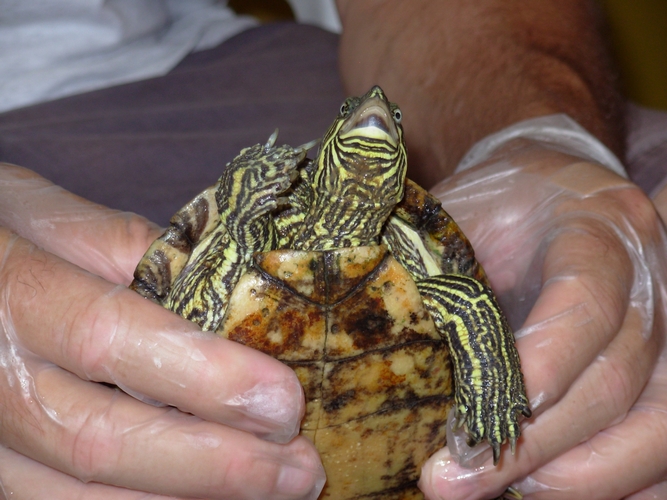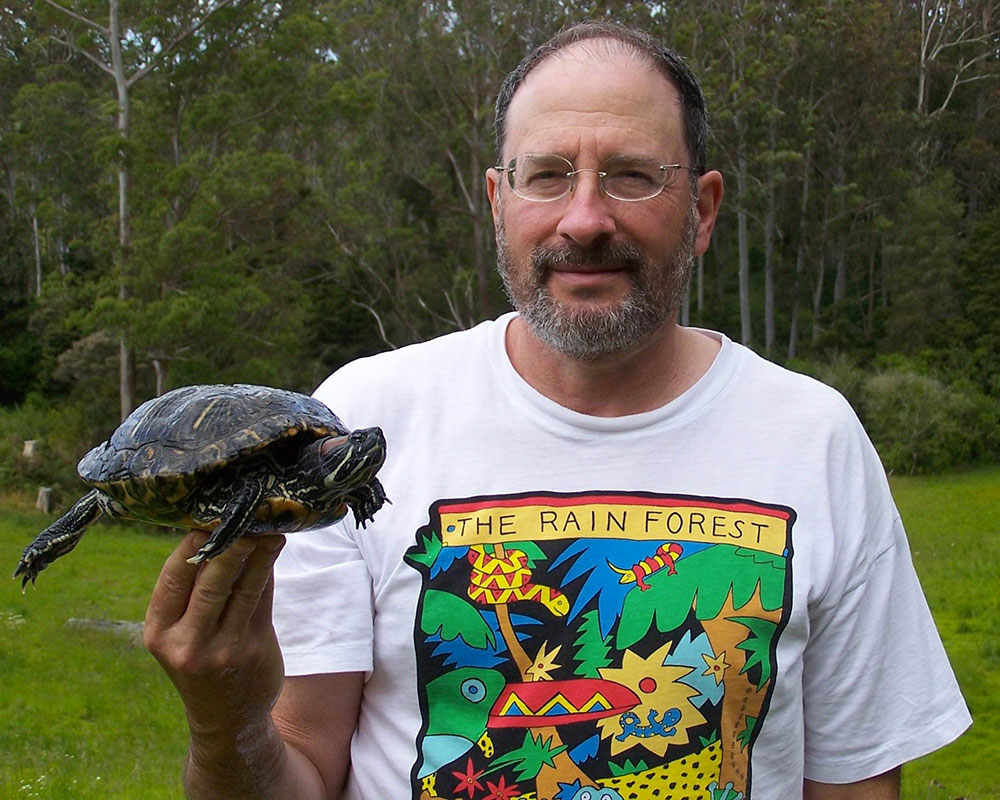
Liz Feldman with a 4 wheeler loaded with softshell turtles ready to go back to the pond.

Mark Feldman with a gravid common snapper ( Chelydra serpentina) before induction.
Our names are Mark and Elizabeth Feldman. We live in the USA and New Zealand. We have also done, and continue to do, our research in both counties. In 1977 we visited John Legler’s lab at the University of Utah to see his extensive collection of Australian turtles. John was not there but his graduate student, Jim Berry, was. When we complained to Jim that we found it difficult to catch hatchling turtles for our home aquarium he suggested that we “make them.” Jim then taught us how to induce turtles to lay their eggs by giving them an intraperitoneal injection of oxytocin. The process was simple; inject the female, incubate the eggs for two months and, presto, you’ve got hatchling turtles for the home aquarium. But, of course, it wasn’t that simple at all.
From 1978 to 2006 we experimented with inducing egg laying using oxytocin alone, oxytocin + ketamine, arginine vasotocin (AVT), propranolol + oxytocin and propranolol +AVT. We induced 245 turtles over those 28 years. Because we used wild turtles and some pet turtles as subjects there was no way to standardize our results. Some species responded pretty well to oxytocin but otherwise our results were inconsistent and we found there were three significant side effects of oxytocin: poor results, inhibition of ovulation of the next clutch and false nesting. However, we did determine that egg viability for eggs induced with oxytocin was equal to wild nest eggs. Details of that study can be found under the heading “2007 article.”

The entrance to the Concordia Turtle Farm in Wildsville, Louisiana where we have done most of our work.
We knew that there had to be a better way of inducing turtles but to find it we had to have access to lots of healthy turtles at one time so we could do valid comparison studies. We found that place at the Concordia Turtle Farm in Wildsville, Louisiana. The Evans family owned the farm and were very generous with their time and resources. Alvin Atlas, a small animal veterinarian, and his wife Jill, helped us out at the farm, supplied materials, and provided advise through the years. John Carr, professor of biology at the University of Louisiana provided logistical support and local insight.

Our above-ground facility for red-eared sliders (Trachemys scripta elegans) in New Zealand. This is the view from our living room so we can observe the turtles closely for side effects after being induced.
From 2008-2019 we were able to induce about 4,000 turtles; mostly red-eared sliders, map turtles and spiny soft-shells. In addition we had a colony of 13 red-eared sliders in New Zealand where we lived. Those females had every clutch induced from 1995-2019. There were 1-5 inductions per year, per turtle, and we were able to observe those turtles carefully for side-effects since they lived in raised ponds within sight of our house.

A red-eared slider (Trachemys scripta elegans). This species served as a model for a medium sized turtle.

A sabine map turtle (Graptemys ouachitensis). This species served as our model of a small turtle with rather large eggs.

A spiny soft shell turtle (Trionyx spiniferus). This was our model for a large turtle with many eggs.
This project is on-going.
The newest information will be in the “primary data” section of this website or the PDF.

